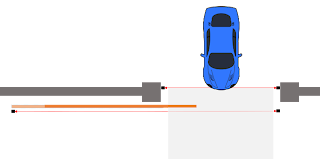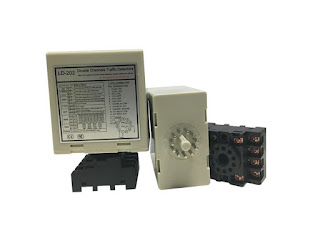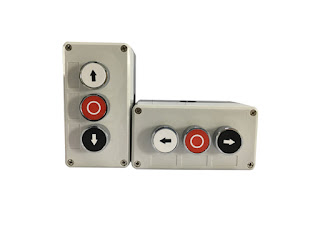What are gate automation photocells and what’s their function?
What are gate automation photocells and what’s their function?
Automatic gates open and
close when instructed by a variety of methods. Remote transmitters are carried
by gate owners to operate their gates at the push of a button on the remote.
Access control systems use gate release buttons inside the property to open the
gates. And keypads or proximity readers installed outside the gates allow
access for anyone with the code or programmed proximity tag.
It is also
possible to bury a loop cable in the driveway inside the gates that operates
the gates when a vehicle passes over it.
However,
moving gates should not be allowed to hit anything or anyone, so a way to tell
them that something is in their path is needed. This is what safety photocells
are for.
What are gate automation photocells and what’s their function?
A Typical Swing Gate Automation Photocell Set Up
With swing
gates, a pair of photocells should be placed just outside the gates (assuming
they open inward) on opposite sides of the drive and facing each other. A
second pair should be placed inside the gates across the driveway but just
outside the reach of the fully open gates.
Arriving at Automatic Swing Gates from the Outside
If gates
are closing and a vehicle arrives from the outside, the outside photocell beams
is broken, and the gate stops closing and reverses to open the gates and
prevent them hitting the vehicle.
A vehicle that has
passed through the outside photocells then breaks the inside photocells’ beam
and prevents the gates closing until it has passed through and the beam is
re-established. Then, after the appropriate time delay, the gates will close.
Arriving at Automated Swing Gates from the Inside
Vehicles
approaching open gates from the inside as the gates are closing will break the
inside photocell beam and stop the gates closing. They reverse and open fully
allowing the vehicle to pass through.
Smaller Vehicles and Pedestrians
The time
delay set to keep gates open after a beam is re-established is important where
slow moving smaller vehicles or pedestrians pass through gates. This is because
at some point the person or vehicle will not be breaking either the inside or
outside beams. Where long gates such as a single 5-bar gate is installed, even
a car can be in a position where it is breaking neither beam.
The potential danger this
situation creates can be reduced by adding safety edges to the gates. The gates
will then stop and reverse if they close on an object between the inside and
outside photocell beams. Installing 24V gate motors with obstacle detection
will achieve the same result. However, this does involve contact with the gates.
One
alternative is to install latching relays which latch the gate open when one
set of photocells’ beams is interrupted and only release the open latch command
when the relay on the second set of photocells is activated by breaking their
beam.
Once the
vehicle or pedestrian breaks the inside beam, the gates will be kept open until
they pass through and the beam is no longer broken.
It may be
considered obvious that any delay between unbroken photocell beams will cause
the gates to close. However, while the homeowners can be educated to this risk,
visitors who have no experience with automatic gates will not be aware of the
possible dangers and the workings of automatic gates. Consequently, it is
always vital to reduce any possible risk with safety equipment or by preventing
access to danger areas.
One final
solution for removing pedestrian access to possible risk areas in gates
designed for vehicle access is facilitated by the installation of a separate
pedestrian gate. This can be locked with an electric lock that can be released
through the access control system used for the automatic gates, but the gate
itself will be manually opened and closed.
Sliding Automatic Gates
Automated
sliding gates slide along the property boundary when opening. Ideally,
photocells should be installed along the full travel path of sliding
gate.
There is a
possibility of shearing and trapping injuries where the gate slides against the
edges of walls and posts or across open railings. This means that safety
photocells on the inside of the gate must accommodate the full travel of the
gates to stop the gates moving if it is possible for anyone to enter the danger
area.
By installing a
pair of photocells just outside the gates, anything that breaks their beam when
the gates are closing will stop and open the gates
The photocells installed
inside the gates stop and open closing gates when anything breaks their beam.
Can Photocells be used for Egress?
As gates
stop closing and open when the beam inside the gates is broken, photocells
could be considered as a cheap option for egress control. However, this is not
recommended, as it is possible for animals including pets or birds to break the
inside beam and cause gates to open at undesirable times. Therefore, safety
photocells should be used as just that, safety devices. Their role is to
prevent gates from closing onto people or vehicles.
The egress
function for anyone wishing to open gates and exit the property should be
performed by alternative methods such as loop detectors or push to exit
buttons.
A loop
detector comprises the detector itself and a loop of special cable. The cable
is buried in the driveway and opens the gate via the loop detector when a
vehicle passes over the loop. These are highly reliable and long-lived and
represent one of the best ways to operate gates automatically from inside the
gates. The only real downside is that a channel for the loop has to be cut in
the driveway and filled with (usually) bitumen, or the loop is installed in the
foundation of a new driveway.
An button is placed
next to the drive inside the gates (sufficiently far back from swing gates to
allow them to fully open) and is simply pushed to open the gates and allow
anyone the leave the property. It is essential that egress buttons are not
positioned near enough to the gate that it is possible to reach through the
gates to operate the push to open button. This is extremely dangerous and there
have been significant injury and death caused to people trapped by opening
gates they have opened by reaching through the gates to push the release
button.
Different Types of Photocells
The most
common combination of two photocells is a transmitter and receiver. The first
emits the infrared beam and the second detects its presence. Alternatives
include photocells that transmit an infrared beam at a mirror ‘receiver’ that
reflects the beam back to the transmitter to also receive the signal. However,
these should only be used for egress and not for safety.
When
choosing photocells, transmitter and receiver pairs are preferable as direct
sunlight and rain can affect the efficiency of reflector types.
Positioning Photocells
Photocells
are a vital part of gate automation safety and their positioning determines a
large part of how safe automatic gates are. In all cases, a safety audit
determining the type of gates, their environment, gate use, frequency of
operation and user knowledge must be carried out at the design stage. This will
determine possible risk areas and the types of potential risk. Safety
photocells can then be positioned to cover danger areas. Their primary role is
to stop gates continuing to move dangerously when someone or something has
entered a risk area and broken an infrared photocell beam.
Once danger
areas have been identified and photocells positioned appropriately, the next
most important part of photocell installation is their alignment. If the infrared
beams emitted and received by a pair of photocells are not received or
reflected accurately, the photocells are worthless.
Another
important consideration with photocell installation, is their height off the
ground. Various posts and columns are available for photocells and many
position the photocells at a height of around 600mm. Any lower than this and
the beams may pass beneath taller vehicles such as 4x4 pick-ups. Any higher and
the beams may pass through the windows of low sports cars or completely over
the top of convertibles with their tops down.
If you want
any advice or further guidance on installing photocells, call Una Lee
+8618179436113
Email:una8jutai@gmail.com
Photocells sensor
infrared photocell beam sensor
Email:una8jutai@gmail.com
Photocells sensor
infrared photocell beam sensor


















评论
发表评论